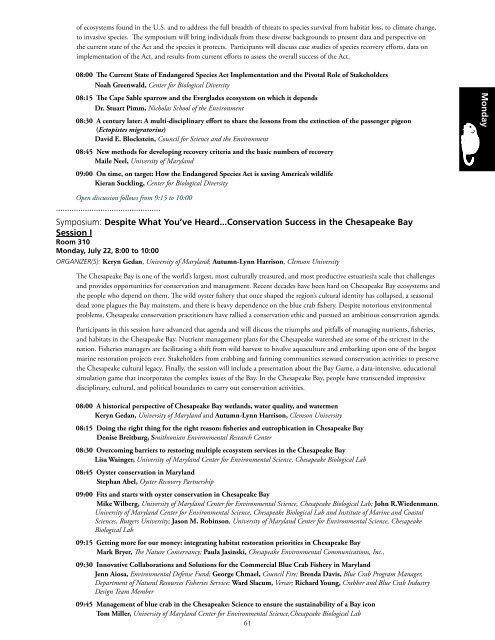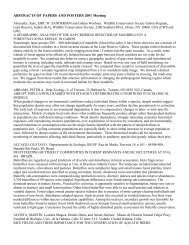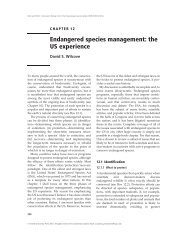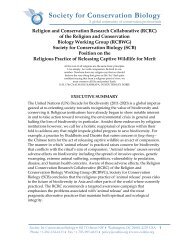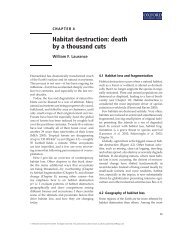ICCB 2013 Program - Society for Conservation Biology
ICCB 2013 Program - Society for Conservation Biology
ICCB 2013 Program - Society for Conservation Biology
Create successful ePaper yourself
Turn your PDF publications into a flip-book with our unique Google optimized e-Paper software.
of ecosystems found in the U.S. and to address the full breadth of threats to species survival from habitat loss, to climate change,<br />
to invasive species. The symposium will bring individuals from these diverse backgrounds to present data and perspective on<br />
the current state of the Act and the species it protects. Participants will discuss case studies of species recovery ef<strong>for</strong>ts, data on<br />
implementation of the Act, and results from current ef<strong>for</strong>ts to assess the overall success of the Act.<br />
08:00 The Current State of Endangered Species Act Implementation and the Pivotal Role of Stakeholders<br />
Noah Greenwald, Center <strong>for</strong> Biological Diversity<br />
08:15 The Cape Sable sparrow and the Everglades ecosystem on which it depends<br />
Dr. Stuart Pimm, Nicholas School of the Environment<br />
08:30 A century later: A multi-disciplinary ef<strong>for</strong>t to share the lessons from the extinction of the passenger pigeon<br />
(Ectopistes migratorius)<br />
David E. Blockstein, Council <strong>for</strong> Science and the Environment<br />
08:45 New methods <strong>for</strong> developing recovery criteria and the basic numbers of recovery<br />
Maile Neel, University of Maryland<br />
09:00 On time, on target: How the Endangered Species Act is saving America’s wildlife<br />
Kieran Suckling, Center <strong>for</strong> Biological Diversity<br />
Monday<br />
Open discussion follows from 9:15 to 10:00<br />
...............................................<br />
Symposium: Despite What You’ve Heard...<strong>Conservation</strong> Success in the Chesapeake Bay<br />
Session I<br />
Room 310<br />
Monday, July 22, 8:00 to 10:00<br />
Organizer(s): Keryn Gedan, University of Maryland; Autumn-Lynn Harrison, Clemson University<br />
The Chesapeake Bay is one of the world’s largest, most culturally treasured, and most productive estuariesa scale that challenges<br />
and provides opportunities <strong>for</strong> conservation and management. Recent decades have been hard on Chesapeake Bay ecosystems and<br />
the people who depend on them. The wild oyster fishery that once shaped the region’s cultural identity has collapsed, a seasonal<br />
dead zone plagues the Bay mainstem, and there is heavy dependence on the blue crab fishery. Despite notorious environmental<br />
problems, Chesapeake conservation practitioners have rallied a conservation ethic and pursued an ambitious conservation agenda.<br />
Participants in this session have advanced that agenda and will discuss the triumphs and pitfalls of managing nutrients, fisheries,<br />
and habitats in the Chesapeake Bay. Nutrient management plans <strong>for</strong> the Chesapeake watershed are some of the strictest in the<br />
nation. Fisheries managers are facilitating a shift from wild harvest to bivalve aquaculture and embarking upon one of the largest<br />
marine restoration projects ever. Stakeholders from crabbing and farming communities steward conservation activities to preserve<br />
the Chesapeake cultural legacy. Finally, the session will include a presentation about the Bay Game, a data-intensive, educational<br />
simulation game that incorporates the complex issues of the Bay. In the Chesapeake Bay, people have transcended impressive<br />
disciplinary, cultural, and political boundaries to carry out conservation activities.<br />
08:00 A historical perspective of Chesapeake Bay wetlands, water quality, and watermen<br />
Keryn Gedan, University of Maryland and Autumn-Lynn Harrison, Clemson University<br />
08:15 Doing the right thing <strong>for</strong> the right reason: fisheries and eutrophication in Chesapeake Bay<br />
Denise Breitburg, Smithsonian Environmental Research Center<br />
08:30 Overcoming barriers to restoring multiple ecosystem services in the Chesapeake Bay<br />
Lisa Wainger, University of Maryland Center <strong>for</strong> Environmental Science, Chesapeake Biological Lab<br />
08:45 Oyster conservation in Maryland<br />
Stephan Abel, Oyster Recovery Partnership<br />
09:00 Fits and starts with oyster conservation in Chesapeake Bay<br />
Mike Wilberg, University of Maryland Center <strong>for</strong> Environmental Science, Chesapeake Biological Lab; John R.Wiedenmann,<br />
University of Maryland Center <strong>for</strong> Environmental Science, Chesapeake Biological Lab and Institute of Marine and Coastal<br />
Sciences, Rutgers University; Jason M. Robinson, University of Maryland Center <strong>for</strong> Environmental Science, Chesapeake<br />
Biological Lab<br />
09:15 Getting more <strong>for</strong> our money: integrating habitat restoration priorities in Chesapeake Bay<br />
Mark Bryer, The Nature Conservancy; Paula Jasinski, Chesapeake Environmental Communications, Inc.,<br />
09:30 Innovative Collaborations and Solutions <strong>for</strong> the Commercial Blue Crab Fishery in Maryland<br />
Jenn Aiosa, Environmental Defense Fund; George Chmael, Council Fire; Brenda Davis, Blue Crab <strong>Program</strong> Manager,<br />
Department of Natural Resources Fisheries Service; Ward Slacum, Versar; Richard Young, Crabber and Blue Crab Industry<br />
Design Team Member<br />
09:45 Management of blue crab in the Chesapeake: Science to ensure the sustainability of a Bay icon<br />
Tom Miller, University of Maryland Center <strong>for</strong> Environmental Science,Chesapeake Biological Lab<br />
61


